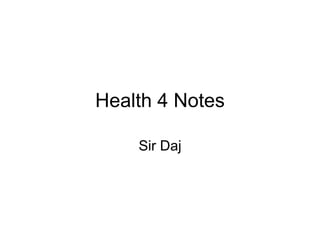
1st qtr health notes
- 1. Health 4 Notes Sir Daj
- 11. Unconscious? Absence of Breathing? Perform BLS!!
- 12. Unresponsive but BREATHING?? . . . Continue with the Assessment
- 13. Vital Signs Pulse Rapid/weak shock, diabetic coma Rapid/strong heat stroke, hypertension Slow/strong stroke, skull fracture None cardiac arrest
- 14. Vital Signs Respiration Shallow shock Irregular obstruction Wheezing asthma None cardiac arrest
- 15. Vital Signs Blood Pressure < 100 mmHg shock > 135 mmHg hypertension Skin Temperature Hot dry heat exposure Cool clammy shock
- 16. Vital Signs Pupils Constricted drugs, poison Unequal concussion, stroke Dilated shock, hemorrhage
- 19. Opening The Airway Head Tilt Chin Lift Jaw Thrust
- 20. FBAO F oreign B ody A irway O bstruction
- 21. Types of Obstruction Anatomical Mechanical Partial Complete Partial Complete
- 24. Cardiovascular Emergencies A rapid decline in heart function due to poor blood flow or electrical activity. LIFE THREATENING!! Examples are cardiac arrest, heart attack, and arrhythmia
- 25. THREE CONDITIONS OF CARDIAC ARREST 1. Cardio Vascular Collapse The heart is still beating but its action is so weak that is not being circulated through the vascular system to the brain body tissues. 2. Ventricular Fibrillation Occurs when the individual fascicles of the heart beat independently rather than the coordinated, synchronized manner that produce rhythmic heart beat. 3. Cardiac standstill It means that the heart has stopped beating.
- 26. Cardiovascular Emergencies Heart attack is the death of the heart muscle due to deficient blood supply. Usually mistaken for angina pectoris . What causes heart attack?
- 27. What are the symptoms? First Aid? 1. Check ABCs 2. Call EMS 3. If possible, give nitroglycerine 4. If needed, use AED
- 30. Basic Life Support A term used to describe the first aid procedures necessary to sustain life when the cardiovascular system is compromised. determine responsiveness
- 31. Basic Life Support A term used to describe the first aid procedures necessary to sustain life when the cardiovascular system is compromised. activate EMS
- 32. Basic Life Support A term used to describe the first aid procedures necessary to sustain life when the cardiovascular system is compromised. open the airway
- 33. Basic Life Support A term used to describe the first aid procedures necessary to sustain life when the cardiovascular system is compromised. determine breathlessness
- 34. Basic Life Support A term used to describe the first aid procedures necessary to sustain life when the cardiovascular system is compromised. give chest compressions
- 35. Basic Life Support A term used to describe the first aid procedures necessary to sustain life when the cardiovascular system is compromised. give rescue breathing 5 cycles in 2 minutes
- 36. Basic Life Support A term used to describe the first aid procedures necessary to sustain life when the cardiovascular system is compromised. defibrillate if available
- 37. Basic Life Support A term used to describe the first aid procedures necessary to sustain life when the cardiovascular system is compromised. recovery position
- 39. When to S.T.O.P. CPR SPONTANEOUS signs of circulation are restored. TURNED over to medical services or properly trained and authorized personnel. OPERATOR is already exhausted and cannot continue CPR. PHYSICIAN assumes responsibility (declares death, take over, etc.).
- 40. Adult Child Infant Compression area Lower half of the sternum 2 fingers from the substernal notch Lower half of the sternum 1 finger from substernal notch Lower half of the sternum 1 finger width below the imaginary nipple line Depth Approximately 1½ - 2 inches Approximately 1 – 1½ inches Approximately ½ - 1 inch How to Compress Heels of 1 hand, other hand on top. Heel of one hand 2 fingers (middle & ring fingertips) Rate of Compression Approximately 100/min Approximately 100/min At least 100/min
- 41. A utomated E xternal D efibrillators are medical devices that deliver a controlled shock through pads or electrodes placed in specific locations on the victim’s chest. What is a fibrillation?
- 44. Using an AED 3. Be sure no one is touching the victim and press ANALYZE 4. Deliver a SHOCK if indicated